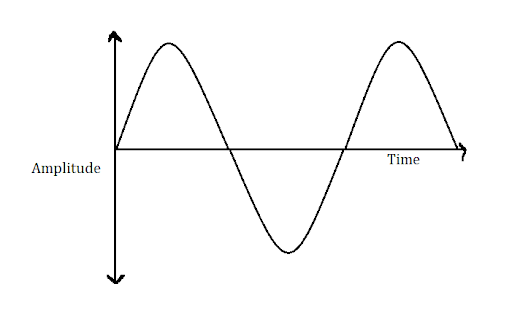
What is the formula for sine waves?
Answer
219k+ views
Hint:The sine wave is described as the waveform in which the amplitudes are always proportional to the displacement angle at every point. The sine or sinusoidal wave is a curve that describes the smooth repetitive oscillation.
Complete step by step solution:
A Sinusoidal wave is a form of the geometrical wave which oscillates up, down, right and left. It is used to reduce the complexity of the wave that is coming in the mathematical formulation. The basic formulation of the sine wave is written as;
\[y(t) = A\sin (2\pi ft + \varphi )\]
And it is also written it as;
\[y(t) = A\sin (\omega t + \varphi )\]
here, $\omega = 2\pi ft$
The sine wave is shown in the figure below,

Image: Sinusoidal wave
In the mathematical expression we have the following representation which is defined as;
1. $A$ is defined as the amplitude of the sine wave. It is defined as the maximum displacement or distance covered by the sinusoidal wave when the body is vibrating.
2. $f$ is defined as the frequency. It is defined as the number of repeating events that can occur at a particular time.
3. $t$ is known as the time period of vibration.
4. $\varphi $ is known as a phase. It is defined as the relationship between the two sine waves.
5. $\omega $ is known as the angular frequency.
Hence formula of sine wave is \[y(t) = A\sin (\omega t + \varphi )\].
Note: There are three characteristics that separate the two or more sinusoid waves from each other. These characteristics are known as amplitude. Frequency and the phase. The application of the sine wave is that it is used in the transmission because it is a more efficient form of a wave as compared to the other waves.
Complete step by step solution:
A Sinusoidal wave is a form of the geometrical wave which oscillates up, down, right and left. It is used to reduce the complexity of the wave that is coming in the mathematical formulation. The basic formulation of the sine wave is written as;
\[y(t) = A\sin (2\pi ft + \varphi )\]
And it is also written it as;
\[y(t) = A\sin (\omega t + \varphi )\]
here, $\omega = 2\pi ft$
The sine wave is shown in the figure below,

Image: Sinusoidal wave
In the mathematical expression we have the following representation which is defined as;
1. $A$ is defined as the amplitude of the sine wave. It is defined as the maximum displacement or distance covered by the sinusoidal wave when the body is vibrating.
2. $f$ is defined as the frequency. It is defined as the number of repeating events that can occur at a particular time.
3. $t$ is known as the time period of vibration.
4. $\varphi $ is known as a phase. It is defined as the relationship between the two sine waves.
5. $\omega $ is known as the angular frequency.
Hence formula of sine wave is \[y(t) = A\sin (\omega t + \varphi )\].
Note: There are three characteristics that separate the two or more sinusoid waves from each other. These characteristics are known as amplitude. Frequency and the phase. The application of the sine wave is that it is used in the transmission because it is a more efficient form of a wave as compared to the other waves.
Recently Updated Pages
Two discs which are rotating about their respective class 11 physics JEE_Main

A ladder rests against a frictionless vertical wall class 11 physics JEE_Main

Two simple pendulums of lengths 1 m and 16 m respectively class 11 physics JEE_Main

The slopes of isothermal and adiabatic curves are related class 11 physics JEE_Main

A trolly falling freely on an inclined plane as shown class 11 physics JEE_Main

The masses M1 and M2M2 M1 are released from rest Using class 11 physics JEE_Main

Trending doubts
JEE Main 2026: Application Form Open, Exam Dates, Syllabus, Eligibility & Question Papers

Understanding Uniform Acceleration in Physics

Derivation of Equation of Trajectory Explained for Students

Hybridisation in Chemistry – Concept, Types & Applications

Understanding the Angle of Deviation in a Prism

Understanding Collisions: Types and Examples for Students

Other Pages
JEE Advanced Marks vs Ranks 2025: Understanding Category-wise Qualifying Marks and Previous Year Cut-offs

Units And Measurements Class 11 Physics Chapter 1 CBSE Notes - 2025-26

NCERT Solutions For Class 11 Physics Chapter 8 Mechanical Properties Of Solids

Motion in a Straight Line Class 11 Physics Chapter 2 CBSE Notes - 2025-26

NCERT Solutions for Class 11 Physics Chapter 7 Gravitation 2025-26

Understanding Atomic Structure for Beginners




